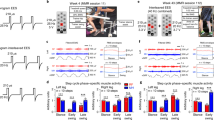Abstract
Six spinal cord injured (SCI) patients were trained to step on a treadmill with body-weight support for 1.5–3 months. At the end of training, foot motion recovered the shape and the step-by-step reproducibility that characterize normal gait. They were then asked to step backward on the treadmill belt that moved in the opposite direction relative to standard forward training. In contrast to healthy subjects, who can immediately reverse the direction of walking by time-reversing the kinematic waveforms, patients were unable to step backward. Similarly patients were unable to perform another untrained locomotor task, namely stepping in place on the idle treadmill. Two patients who were trained to step backward for 2–3 weeks were able to develop control of foot motion appropriate for this task. The results show that locomotor improvement does not transfer to untrained tasks, thus supporting the idea of task-dependent plasticity in human locomotor networks.


Similar content being viewed by others
References
Barbeau H, Danakas M, Arsenault B (1993) The effects of locomotor training in spinal cord injured subjects. Restor Neurol Neurosci 5:81–84
Belanger M, Drew T, Provencher J, Rossignol S (1996) A comparison of treadmill locomotion in adult cats before and after spinal transection. J Neurophysiol 76:471–491
Bohannon RW, Smith MB (1987) Inter-rater reliability of a modified Ashworth scale of muscle spasticity. Phys Ther 67:206–207
Bouyer LJ, Whelan PJ, Pearson KG, Rossignol S (2001) Adaptive locomotor plasticity in chronic spinal cats after ankle extensors neurectomy. J Neurosci 21:3531–3541
Dietz V, Colombo G, Jensen L, Baumgartner L (1995) Locomotor capacity of spinal cord in paraplegic patients. Ann Neurol 37:574–582
Dobkin BH (2000) Spinal and supraspinal plasticity after incomplete spinal cord injury: correlations between functional magnetic resonance imaging and engaged locomotor networks. Prog Brain Res 128:99–111
Duysens J, Tax AA, Murrer L, Dietz V (1996) Backward and forward walking use different patterns of phase-dependent modulation of cutaneous reflexes in humans. J Neurophysiol 76: 301–310
Giszter SF, Kargo WJ, Davies M, Shibayama M (1998) Fetal transplants rescue axial muscle representations in M1 cortex of neonatally transected rats that develop weight support. J Neurophysiol 80:3021–3030
Grasso R, Bianchi L, Lacquaniti F (1998) Motor patterns for human gait: backward versus forward locomotion. J Neurophysiol 80:1868–1885
Grasso R, Ivanenko YP, Zago M, Molinari M, Scivoletto G, Castellano V, Macellari V, Lacquaniti F (2004) Distributed plasticity of locomotor pattern generators in spinal cord injured patients. Brain 127:1019–1034
Grillner S (1981) Control of locomotion in bipeds, tetrapods, and fish. In: Brookhart JM, Mountcastle VB (eds) Handbook of physiology. The nervous system. Motor control, sect 1, vol 2, part 1. Amer Physiol Soc, Bethesda MD, pp 1179–1236
Gurfinkel VS, Levik YS, Kazennikov OV, Selionov VA (1998) Locomotor-like movements evoked by leg muscle vibration in humans. Eur J Neurosci 10:1608–1612
Hodgson JA, Roy RR, de Leon R, Dobkin B, Edgerton VR (1994) Can the mammalian lumbar spinal cord learn a motor task? Med Sci Sports Exerc 26:1491–1497
Ivanenko YP, Grasso R, Lacquaniti F (2000) Influence of leg muscle vibration on human walking. J Neurophysiol 84:1737–1747
Ivanenko YP, Grasso R, Macellari V, Lacquaniti F (2002) Control of foot trajectory in human locomotion: role of ground contact forces in simulated reduced gravity. J Neurophysiol 87:3070–3089
Ivanenko YP, Grasso R, Zago M, Molinari M, Scivoletto G, Castellano V, Macellari V, Lacquaniti F (2003) Temporal components of the motor patterns expressed by the human spinal cord reflect foot kinematics. J Neurophysiol 90:3555–3565
Lamb T, Yang JF (2000) Could different directions of infant stepping be controlled by the same locomotor central pattern generator? J Neurophysiol 83:2814–2824
Maegele M, Muller S, Wernig A, Edgerton VR, Harkema SJ (2002) Recruitment of spinal motor pools during voluntary movements versus stepping after human spinal cord injury. J Neurotrauma 19:1217–1229
Maynard FM Jr, Bracken MB, Creasey G, Ditunno JF Jr, Donovan WH, Ducker TB, Garber SL, Marino RJ, Stover SL, Tator CH, Waters RL, Wilberger JE, Young W (1997) International standards for neurological and functional classification of spinal cord injury. American Spinal Injury Association. Spinal Cord 35:266–274
Pearson KG (2001) Could enhanced reflex function contribute to improving locomotion after spinal cord repair? J Physiol 533:75–81
Pepin A, Norman KE, Barbeau H (2003) Treadmill walking in incomplete spinal-cord-injured subjects: 1. Adaptation to changes in speed. Spinal Cord 41:257–270
Schneider C, Capaday C (2003) Progressive adaptation of the soleus H-reflex with daily training at walking backward. J Neurophysiol 89:648–656
Thorstensson A (1986) How is the normal locomotor program modified to produce backward walking? Exp Brain Res 61:664–668
Topka H, Cohen LG, Cole RA, Hallett M (1991) Reorganization of corticospinal pathways following spinal cord injury. Neurology 41:1276–1283
Wernig A, Muller S, Nanassy A, Cagol E (1995) Laufband therapy based on ‘rules of spinal locomotion’ is effective in spinal cord injured persons. Eur J Neurosci 7:823–829
Witz M, Colombo G, Dietz V (2001) Long term effects of locomotor training in spinal humans. J Neurol Neurosurg Psychiatry 71:93–96
Acknowledgements
We thank the therapists D. Angelini, B. Morganti and M. Piccioni for training the patients, and Dr. L. Ercolani and D. Prissinotti for help with some of the experiments. The financial support of the Italian Health Ministry, Italian University Ministry (FIRB project), and Italian Space Agency (ASI) is gratefully acknowledged.
Author information
Authors and Affiliations
Corresponding author
Additional information
R. Grasso died on 6 October 2000
Rights and permissions
About this article
Cite this article
Grasso, R., Ivanenko, Y.P., Zago, M. et al. Recovery of forward stepping in spinal cord injured patients does not transfer to untrained backward stepping. Exp Brain Res 157, 377–382 (2004). https://doi.org/10.1007/s00221-004-1973-3
Received:
Accepted:
Published:
Issue Date:
DOI: https://doi.org/10.1007/s00221-004-1973-3




